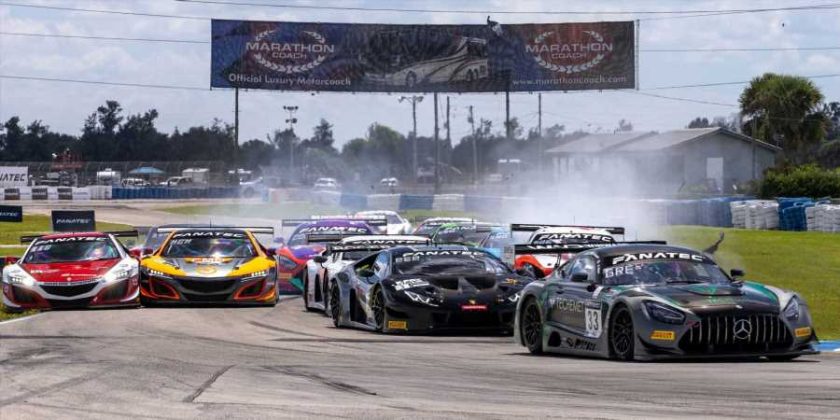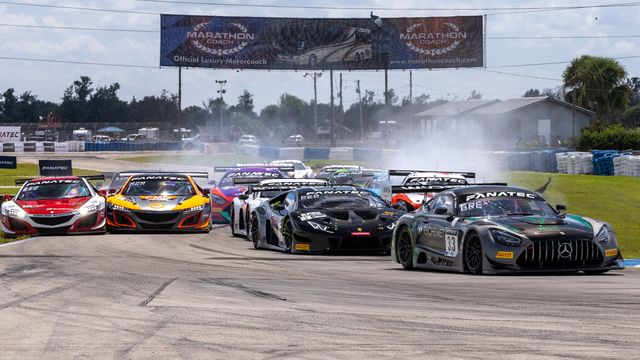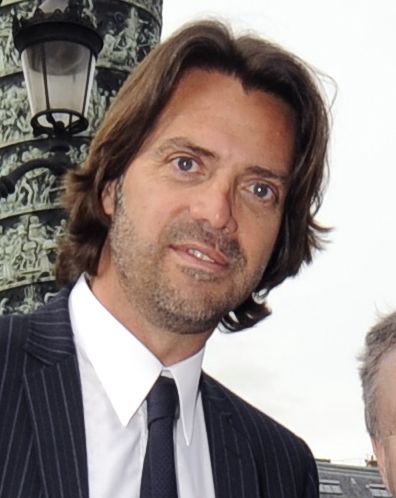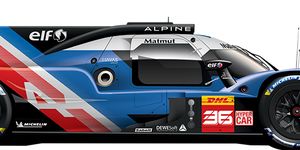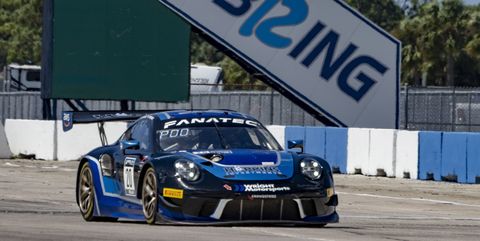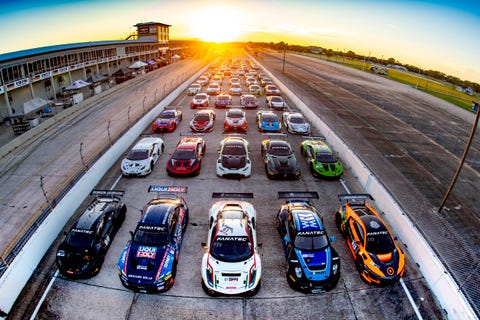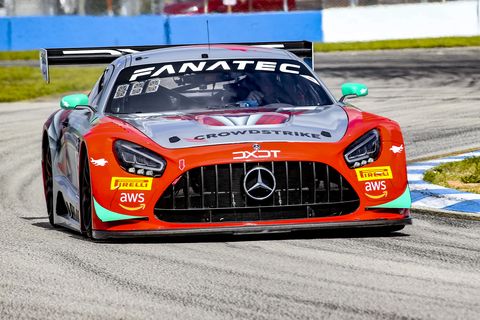To appreciate where the World Challenge series is now, we need to take a quick history lesson on where the series has been, and the long, winding road it’s taken to get to 2021.
Its roots arguably reach back to 1985, when the Sports Car Club of America cobbled together a six-race pro series sponsored by Playboy magazine, and then Escort radar detectors.
In 1990, the series got a new name: World Challenge. Which it wasn’t, really—the name reflected the fact that cars manufactured all over the world were racing against each other, not that the world was coming to the small US series.
It picked up a sponsor in 1999—SpeedVision, the defunct and sorely missed cable network, and it became the Speed World Challenge. The SCCA hung onto the series until 2008, when WC Vision, a group of investors, some of them racers, bought it. In 2011, it became the Pirelli World Challenge, a name that seems to stick in fans’ minds even today, though it hasn’t been the PWC since 2018.
What happened in 2018? The Stephane Ratel Organization, or SRO, became the majority owner of the series, and it was renamed SRO World Challenge America. And that’s where the current chapter begins.
Who is Stephane Ratel? He is the dashing European who started SRO in 1995 with an intent to organize GT racing around the world. And he has: Described on the SRO website as being “a leading decision-maker in international motorsports,” Ratel has offices in the United States, London, Paris, Hong Kong, and Liège, Belgium.
Ratel is the father of the GT3 class—GT racing is Gran Turismo, meaning sports-car based, as opposed to Prototypes, which are based on race designer’s imagination. GT3 is Ferraris, Lamborghinis, Porsches, BMWs, Audis, Mercedes, you name it—all racing against each other.
Which means Ratel is also the father of the Balance of Performance, the formula that adds or subtracts weight, aerodynamics, fuel capacity and multiple other tweaks that essentially slow the fastest brands, speed up the slower brands, so everybody theoretically crosses the finish line based on the team and the driver’s ability, not a horsepower advantage.
There’s also the slightly slower GT4 class—think Toyota Supra, Chevrolet Camaro, Ford Mustang, BMW 2-series—that races separate from the GT3 cars.
In a nutshell: “The focus of SRO America, and SRO Global, is customer racing,” says Greg Gill, president and CEO of SRO America. “We have the best GT racing in the world—that’s not a brag, it’s a statement of how much GT racing we do—using the Balance of Performance and keeping it exciting for the racers, the teams, the manufacturers, and the fans.”
Gill is sitting in the SRO trailer at Sebring International Raceway, where he and his staff—which includes former Mazda executives Jim Jordan and Robert Davis, as well as ex-racers Brian Till and Jack Baldwin—held a successful weekend of racing.
It was relaxed but on time, with a modest but enthusiastic number of fans at the track watching an entry list of more than 100 cars compete. The series exists on its sponsors, notably Fanatec, the manufacturer of video gaming equipment, as well as Pirelli and the Skip Barber school, and racer and manufacturer participation, and not so much on the fans at the track. The same is true of IMSA, just on a much larger scale.
“For the average fan, recognizing the vehicle is critical. GT racing is a class that allows a driver to be the lead factor in the race—pitting a Ferrari against a rear-engine Porsche, BoP was the only way to level the field. Which says you are going to evaluate by the tracks, and vehicle dynamics, what is the fairest way for it to come down to the driver. The manufacturers are certainly battling for every advantage they can get, but at the end of the day, the win is going to the driver and team that best executes.
“And you can now see it around the globe. I believe when SRO started at Monza this year, out of a 40-plus GT3 starting grid, the top 20 were within a tenth of a second of each other.” GT3 isn’t limited to the various Challenge iterations—IMSA, for instance, uses the GT3 formula for its biggest class, GT Daytona.
Being a customer-oriented series, in the past, there has been so much going on under the Challenge umbrella that it was difficult to keep up with it all. “Today, we’re much more easily defined. There are two-driver, 90-minute formats that, in World Challenge, are part of a global championship, and this is now understood by manufacturers, teams and drivers,” Gill says.
“What was important to us in 2020, and now 2021, is remembering our roots and going back to a single-driver format for our GT3 and GT4 drivers who say, ‘I want to be by myself.’ The single-driver format usually attracts the country club-type racers who like it, and we’re able to give them that. It’s changed, but it’s the same—it’s customer racing, but we looked at what was right for the customers in North America.”
There’s a big exception to the above, and it happens October 15-17 with an eight-hour, season-finale endurance race on Indianapolis Motor Speedway’s road course. “The eight-hour is different from what we have here in our penultimate round at Sebring. We have 40-plus cars for the eight-hour. We support what the manufacturers want—we give them a professional program, at the end of the Continental GT Challenge They can come to America, race at Indianapolis, an iconic place, and at the same time fans can follow along with Touring Car, Pirelli GT cars, GT America—it gives them something to relate to from our 32-year history,” Gill says.
So where does SRO Challenge America fit in to the domestic motorsports landscape? In the middle, essentially, with the SCCA and NASA on one side, and IMSA on the other.
“IMSA is endurance racing. We are sprint racing.”
“IMSA is endurance racing. We are sprint racing,” Gill says. We do one endurance race a year, the eight-hour. We do have a 90-minute sprint race with a driver change, and it’s a great place for drivers who say, ‘I want to stay with this format forever,’ and the driver who wants to learn that level of racing because they want to race in the 24 Hours at Daytona or Petit Le Mans or the Sebring 12 Hour someday. And we’re very happy about that.
“We have a slogan that Stephane started but we definitely preach here, ‘We want to grow the pie, not slice it.’ I’m not interested in carving off other series’ driver base, I just want to give people a great GT racing experience. And we do that at a pro racing level—we have prize money, we have television, we have all the things you would expect from a professional racing series.”
If you choose to race in one of the Pro-Am classes, you have the opportunity to match lap times against some of the best sports car racers in the country. Present at Sebring: Memo Gidley, Madison Snow, Jan Heylen, Michael Cooper, Bill Auberlen, the winningest driver in IMSA history, and Ryan Dalziel, overall winner of the Rolex 24 Hours at Daytona. There are more top-shelf pro drivers expected in Indy.
Dalziel says he’s found a comfortable spot in the series. “The GT3 budget here is 40 to 50 percent of what it is in IMSA,” which admittedly has more and longer races. “This is a very good, well-run series for a racer.”
That’s music to Gill’s ears.
“We know where we fit in the hierarchy and it’s definitely below IMSA,” Gill says. “We’re a stepping-stone for people who want to go endurance racing, and by the same token if they want to stay with our format, and we have many people who have been with us for decades, and we’re very thankful for that customer.”
The series also attracts drivers and teams who have been very successful on the SCCA or NASA level, or in single-marque series like Porsche Carrera Cup or Lamborghini Trofeo or Ferrari Challenge—and they want to take that step up into pro racing, because someday, they want to go to Le Mans, and before they get there they’ve got to learn Daytona, and the 12 Hours at Sebring, “and we’re part of that journey,” Gill says. “And we’re very comfortable there.”
Battle between these three coming on the last lap!
⏱ https://t.co/TubiRzirMo
💻 https://t.co/oh9iwUO8ui
📻 SiriusXM 392 and 992#GTSebring | #GTAmerica pic.twitter.com/RI6lZeJ4OE
Gill says he works closely with IMSA, and vice versa. They compare schedules at the start of the year to make sure their events don’t overlap, because plenty of drivers want to race in both series. This year, IMSA needed some track time for a Lamborghini Trofeo and Carrera Cup race, which they sanction, and Gill found room on the Challenge schedule for Virginia International Raceway and Circuit of the Americas to accommodate them.
In return, John Doonan, IMSA president, and David Pettit, the marketing director, helped make it possible for SRO Challenge America to race at Sebring, which, like IMSA, is essentially owned by NASCAR.
Bottom line, “We’re part of the motorsports path in America,” Gill says. “Maybe you start with an SCCA Track Night in America, and you enjoy it. We all know speed is a gateway drug, and the people who like it decide to take a step up. I can’t tell you how many customers we have who say, that I’ve won everything in the SCCA. They say they’re not getting high enough on that drug anymore, they’ve got to try a stronger dose. And they come to us.”
Source: Read Full Article
